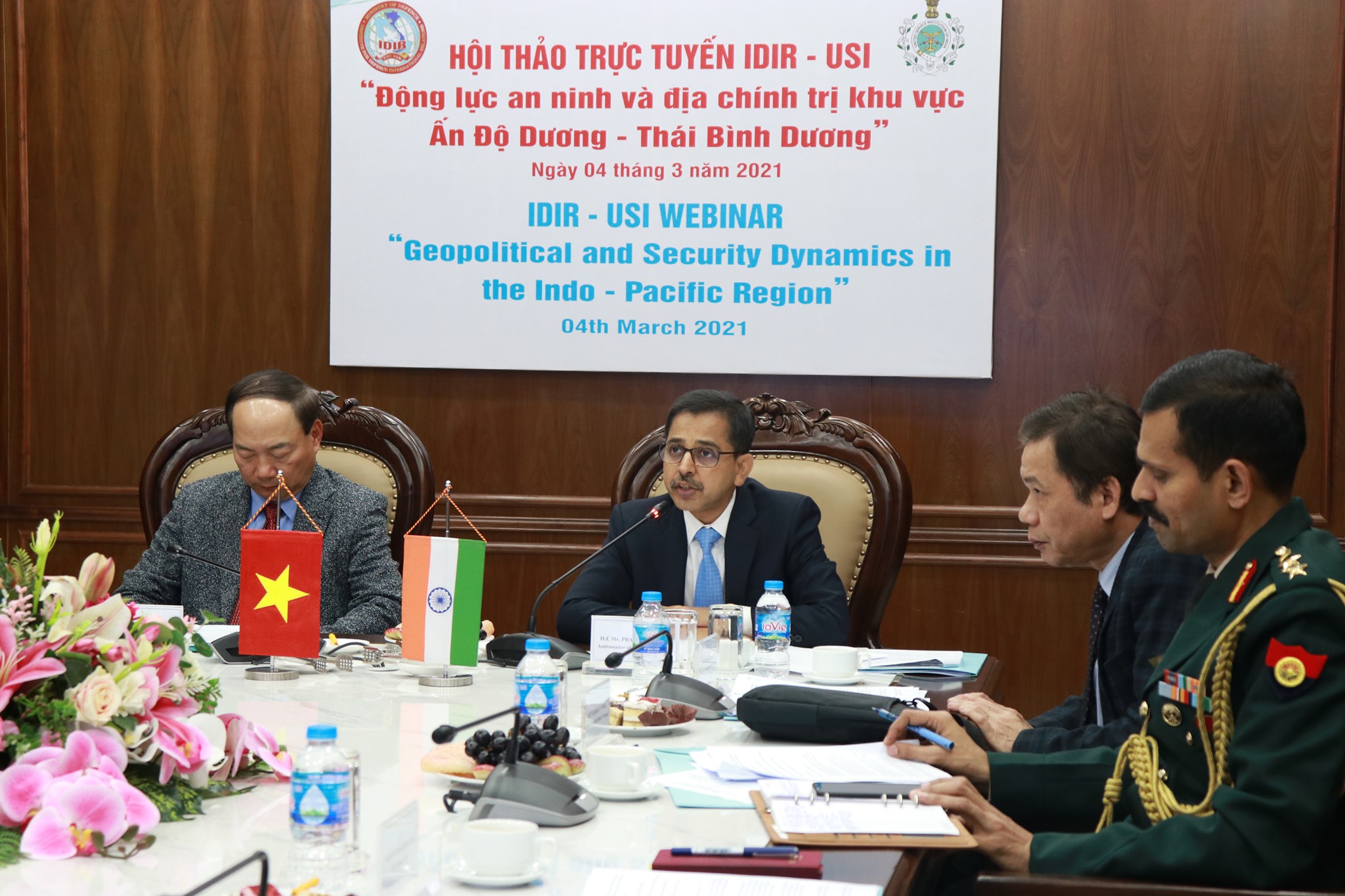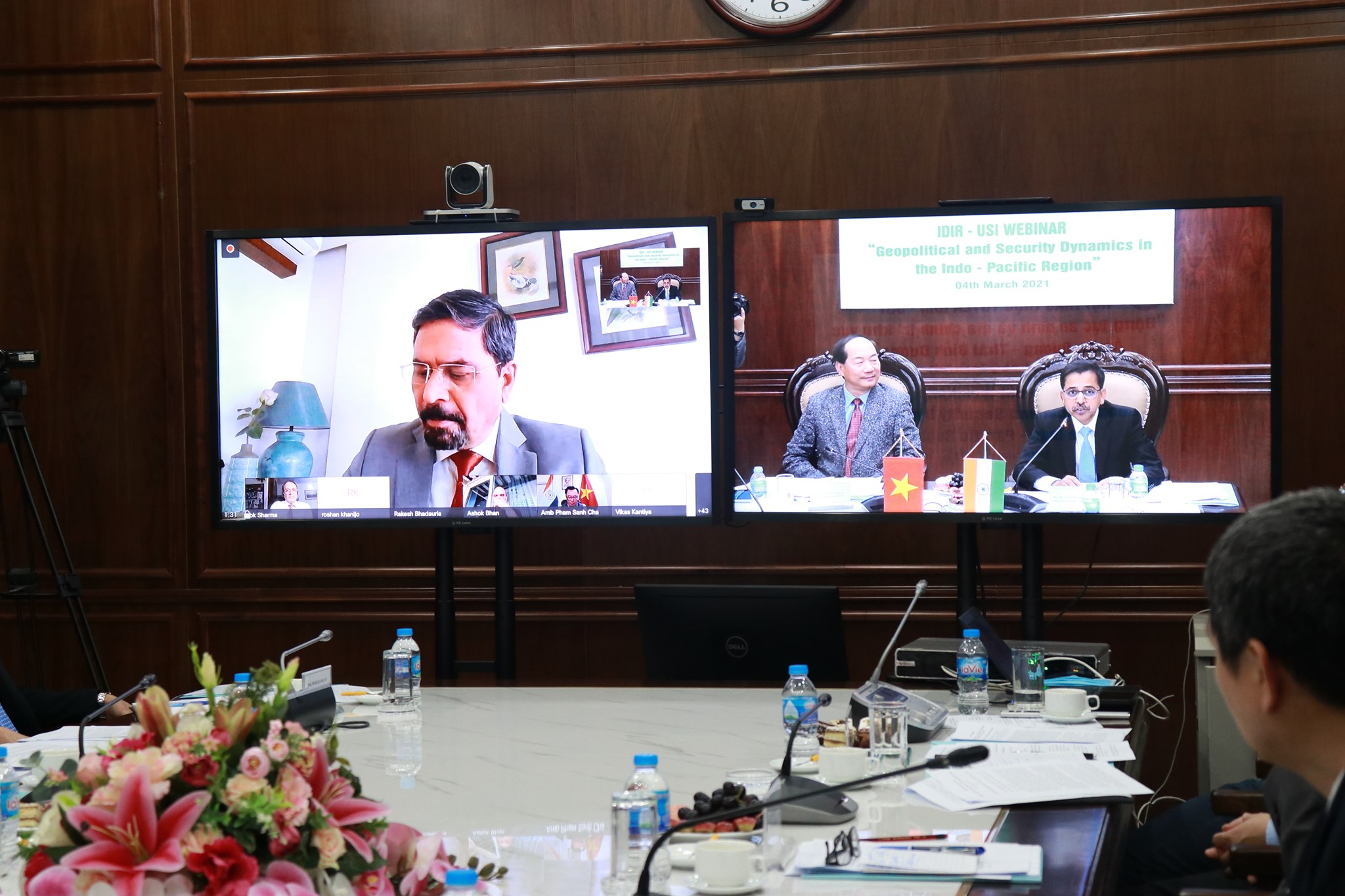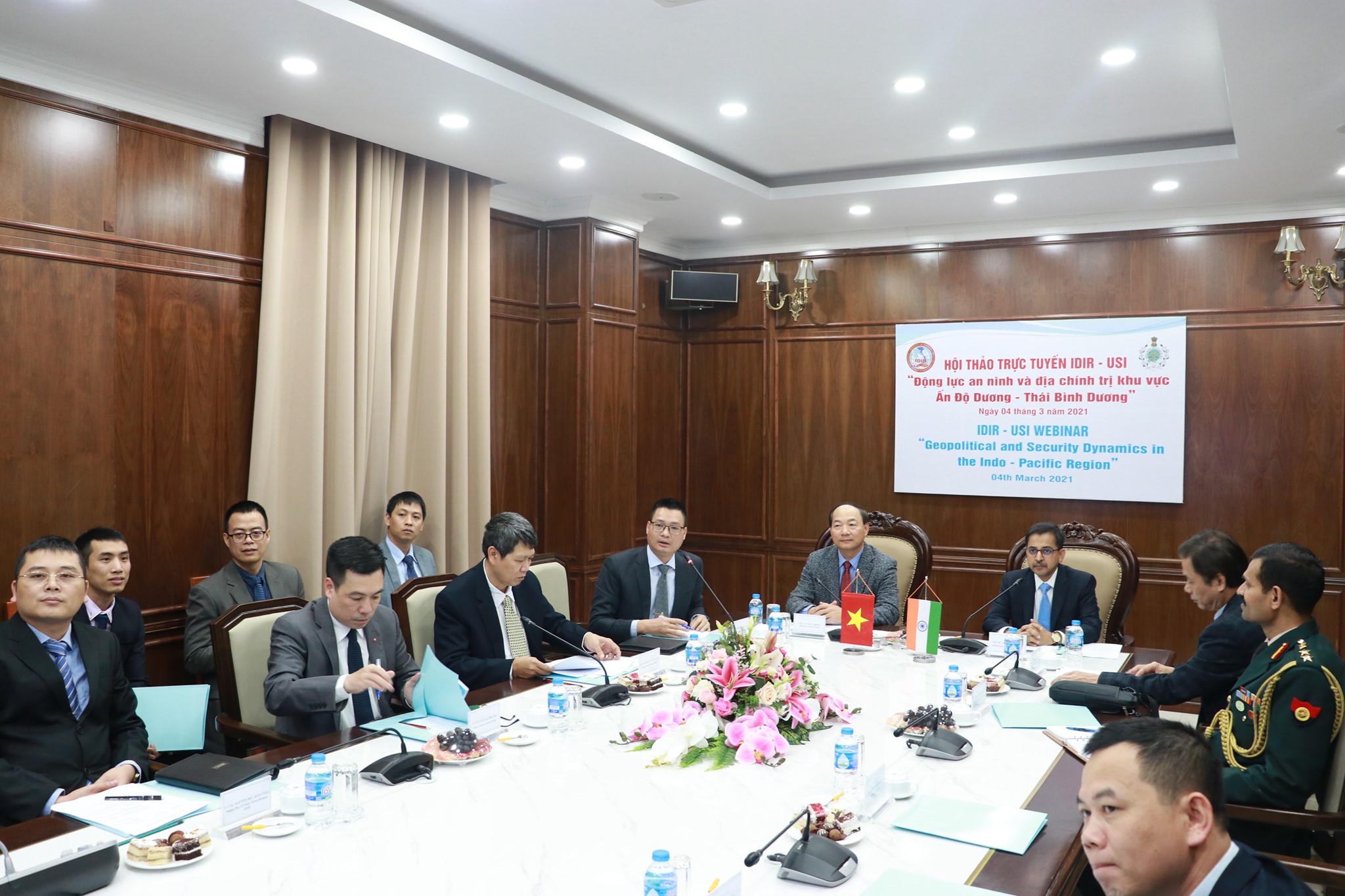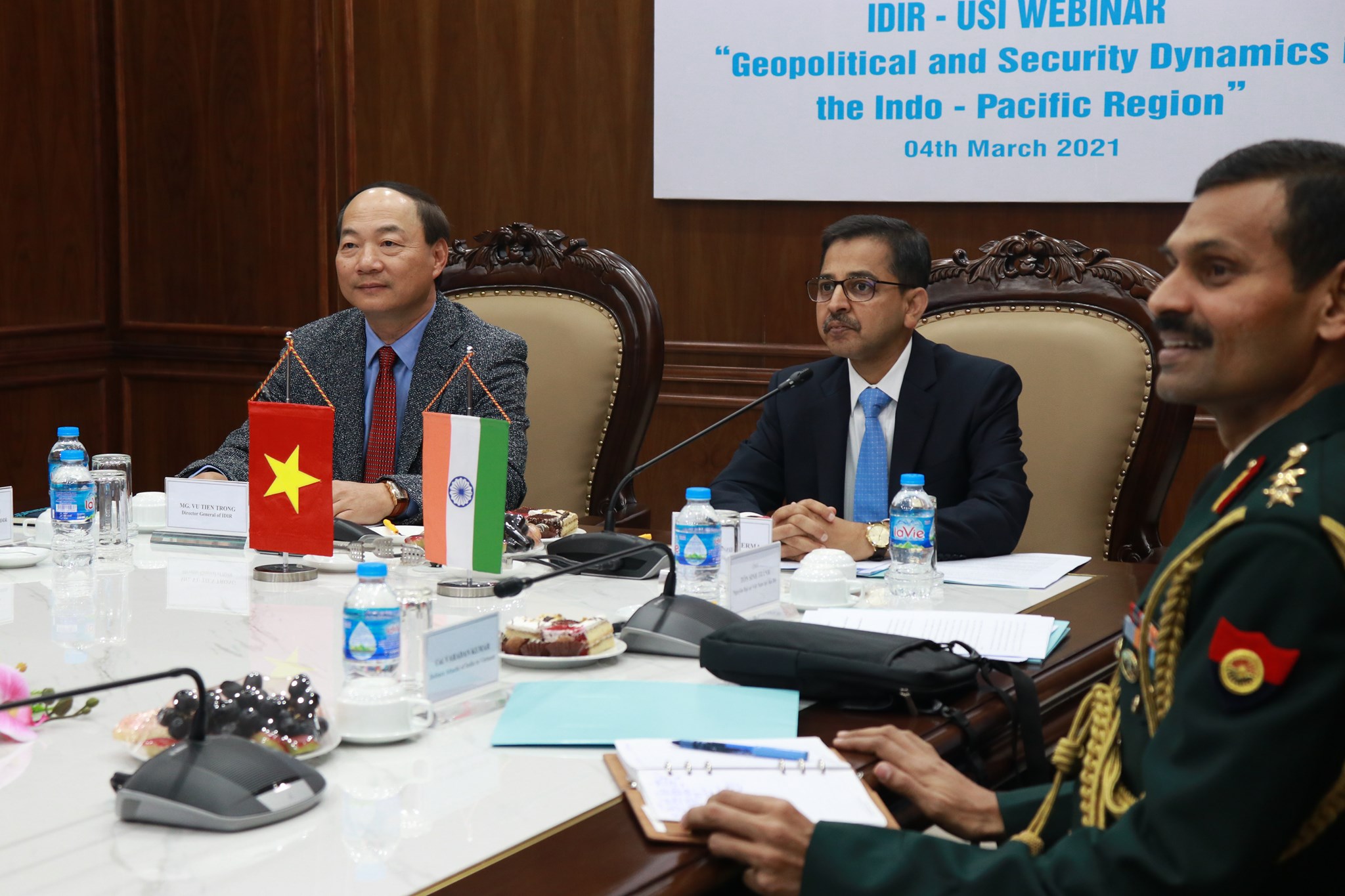
Director of United Services Institution, General B.K Sharma,
Director of Institute of Defence International Relations, General Vu Tien Trong,
Vietnam’s Ambassador to India, His Excellency Pham Sanh Chau,
Former Ambassador of Vietnam to India, His Excellency Ton Sinh Thanh
Distinguished senior colleagues and participants at today’s webinar,
Ladies and Gentlemen.
***
I thank both USI and IDIR for inviting me at today’s event.
As thinktanks dedicated to studying national security issues and in particular, their implications for national defence, both USI and IDIR are eminently placed to deliberate and contribute to our collective understanding of the geopolitics and security dynamics in the Indo-Pacific.
I have had the privilege of interacting with IDIR and engaging with their scholars on a number of occasions during my stay in Vietnam over the last one and half years. They are not only repositories of great strategic understanding of the region; they also share interest, empathy and sensitivity on many issues of India’s interests and concerns. I am happy that USI and IDIR have maintained regular engagement under their bilateral institutional arrangement, even using online platforms in these times of disruptions caused by COVID-19.
Today’s topic – Geopolitics and Security Dynamics in the Indo-Pacific Region – is a very relevant one to both India and Vietnam, not only because we are situated in the Indo-Pacific region, but also because we depend so extensively on its peace and security to advance our priorities of national well-being and development.
An important preface to our conversation on the geopolitics and security dynamics in the region, in my view, is to also understand how we look at the construct of Indo-Pacific itself and what it entails.
As a geographical region, Indo-Pacific is relatively easy to conceptualize with minor variations, as a region straddling the Indian and the Pacific Oceans.
At the same time, we should have a clear understanding of not just the contestations and fault-lines that exist in the region, but also of the choices for collaboration and co-existence that are important for the region.
And therein lies our appreciation of the geopolitics of the region and our perception of the attendant opportunities and challenges.
In my remarks, I will be happy to touch upon how we view these multiple strands as part of India’s Indo-Pacific Vision.
***
First, our Indo-Pacific Vision, that was first articulated by Prime Minister Modi in his speech at the Shangri La Dialogue in June 2018, is India’s Indo-Pacific Vision. It is sui generis, though there could be areas of convergences and similarities with others. There are many constructs that have been and are being proposed for the Indo-Pacific and therefore, it is important to make this point.
Second, our Indo-Pacific Vision is premised on two basic recognitions – first, that opportunities and challenges in the Indian and the Pacific Oceans cannot be artificially separated; and the second, that this geographical space represents the new growth realities, the realities of this century, not of the last.
It is therefore in Vietnam’s interest as much as it is in India’s interest that we reflect the inescapable reality of the Indo-Pacific as an intrinsic part of our national strategy – both in thinking and discourse, as well as in terminological description.
***

Geographically, for India, the Indo-Pacific is a vast maritime space stretching from the western coast of North America to the eastern shores of Africa. Over 50% of global trade traverses this maritime domain. It is also home to over 60% of the world’s population and the global GDP. And so, the security and stability of this vast region is vital for the world.
As the largest economy in the Indian Ocean and as a country significantly integrated with the Pacific Ocean through trade, India has a natural interest in the peace, stability and development of the Indo-Pacific region.
India’s Indo-Pacific Vision is a critical component of our doctrine of SAGAR – that is, Security and Growth for All in the Region, as well as a natural extrapolation of our “Act East Policy”. Our vision is for a free, open, peaceful, prosperous and above all, an inclusive region, that believes in a rules-based regional architecture and respects sovereignty of nations.
ASEAN’s centrality is a foundational feature of this vision.
***
Unlike the original connotation of the Asia-Pacific as a theatre of conflict of war times, our Indo-Pacific Vision is a positive construct of development and connectivity, in which India can play a unique role by virtue of its geographical location and economic strength. In some sense, this vision has an economic primacy with emphasis on collective prosperity through collaboration and connectivity.
Of course, in this economic emphasis, collaborative efforts to ensure rules-based order and security are equally vital.
Given the predominantly maritime nature of the region, it is obvious that much of these relate to our efforts to ensure that the global commons are better secured; that freedom of navigation and overflight, and of lawful commerce and economic activities is protected based on international law; and that sovereignty and territorial integrity of countries are respected. It is also about ensuring that any code of conduct for the region is in accord with international maritime laws and practices, and serves the legitimate rights and interests of all.
***
We also see Indo-Pacific as a platform to promote regional multipolarity – one that gives all stakeholders a voice and say in the shaping of the regional order that is fair and just, and abides by universally recognized norms. In other words, the Indo-Pacific construct allows us options to proactively advance our interests through a network of positive interdependencies, rather than reactively confining us to binaries.
The COVID-19 pandemic and the impacts of climate change have added to the pre-existing geopolitical and geo-economic complexities in the region and the world. In many ways, the matrix of security itself has undergone transformation, with issues like climate adaptation, healthcare, supply chain resilience, cross-border mobility – all acquiring greater salience in our security and threat perceptions. Navigating those uncertainties will be a common challenge for all.
***

To translate this vision of partnership and collaboration into practical action, at the East Asia Summit in 2019, Prime Minister Modi further articulated our Indo-Pacific Oceans Initiative (IPOI), which provides a detailed template for partnership-based cooperation across seven verticals – maritime security; maritime ecology; maritime resources; capacity building & resource sharing; disaster risk reduction and management; science, technology and academic cooperation; and trade connectivity/ transport.
As you can see, across its various strands, the IPOI concerns itself with fashioning practical regional responses to deal with traditional and non-traditional security issues on the one hand, and shared challenges like climate change and sustainable development on the other – all while building interconnected stakes in collective well-being and ensuring the foundational centrality of ASEAN in the regional architecture. Indeed, the IPOI does not seek to create any new regional architecture but builds upon the existing ASEAN-led framework.
We are happy that ASEAN countries, including Vietnam, have come up with their own Outlook on the Indo-Pacific (AOIP), which is broadly similar to our Indo-Pacific Vision and Indo-Pacific Oceans Initiative.
The four priority areas of ASEAN’s AOIP – which are maritime partnerships, Sustainable Development Goals, connectivity, and economic partnership – overlap very nicely with India’s Indo-Pacific Oceans Initiative.
This congruity in how we view our shared region is not a mere coincidence but reflects the logical awareness of what we need to do for the region’s security and growth.
Together, ASEAN’s AOIP and India’s IPOI provide a useful roadmap to reinforce our cooperation with ASEAN and promote regional integration, physical and digital connectivity, and economic and development partnership.
***
Let me say a few words about where Vietnam fits in this vision.
We believe that India-Vietnam Comprehensive Strategic Partnership is a critical piece in the Indo-Pacific landscape.
As the Joint Vision adopted during the Virtual Summit of 21st December 2020 by the Prime Ministers of our two countries notes, enhanced defence and security partnership between India and Vietnam is an important factor of stability in the Indo-Pacific region amidst the emerging geopolitical and geoeconomic landscape in the region and beyond.
Indeed, as a close partner of India with multifaceted political, economic and security cooperation and as a key link in India’s engagement with ASEAN, Vietnam is clearly an indispensable partner in our Indo-Pacific Vision, particularly given our shared values and interests in region’s peace and prosperity.
Both India and Vietnam are maritime nations, connected historically by maritime routes. Our shared stakes in peace and stability of our common maritime region and our growing emphasis on maritime interests in our respective national development strategies, make our IPOI and ASEAN’s AOIP a practical basis to promote India-Vietnam strategic partnership in the face of contemporary challenges and opportunities in our shared region.
***

Before concluding, let me add that as the existing geopolitical and geoeconomic scenario in the Indo-Pacific region has been overlaid by the new impacts created by COVID-19, concerns over future pandemics, supply chain overdependencies, mobility disruptions – have all brought to the fore new challenges of an interconnected world. They have also focused our attention to building capacities at home.
In India’s case, the Atma Nirbhar Bharat – or the vision of Self-Reliant India – is a profound response to these challenges. It is not about isolating India. Quite contrary to that, it is about making India self-regenerating and resilient so that India can integrate more effectively with the world and where India’s capacities become an engine for global growth and serve the needs of entire humanity.
Recent developments have shown that whether it is for vaccines or supportive medicines or masks and PPEs, India’s home-grown capabilities are helping the Indo-Pacific region and the larger international community to fight COVID-19. We are confident that India’s economic capacities, developmental aspirations, and capabilities as a first responder will create opportunities and be a pillar of strength for the economic revival, and for peace and stability, of the Indo-Pacific and indeed the entire world post COVID-19. We look forward to working ever more closely with Vietnam in this journey of hope into the future.
I thank you for your attention and wish you a productive and rewarding discussion at this webinar.
***
https://www.facebook.com/media/set/?vanity=IndiaInVietnam&set=a.3859642650768723













